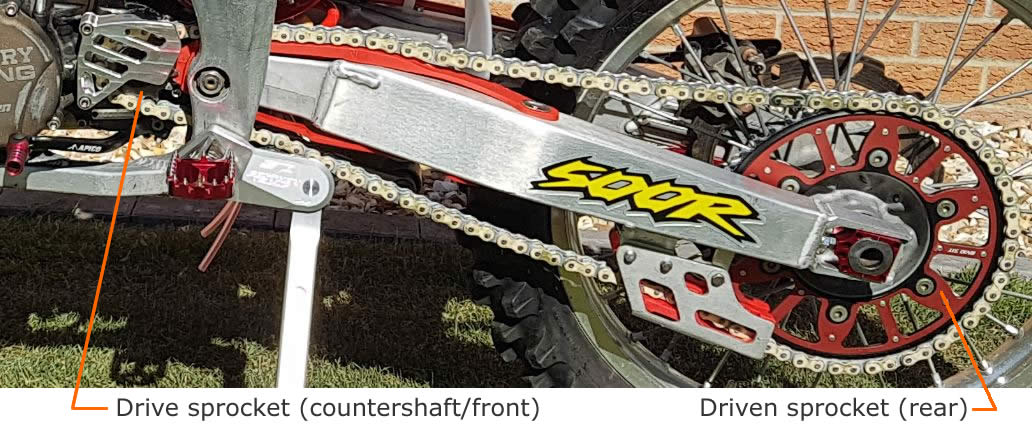
What Is Gear Ratio?
Unless otherwise stated Supermoto gear ratio is referring to the final-drive ratio and not the gearbox. The final-drive ratio comprises of the front and rear sprockets + the chain.
It is calculated by how many times the front sprocket has to rotate in order to turn the rear sprocket one complete revolution.
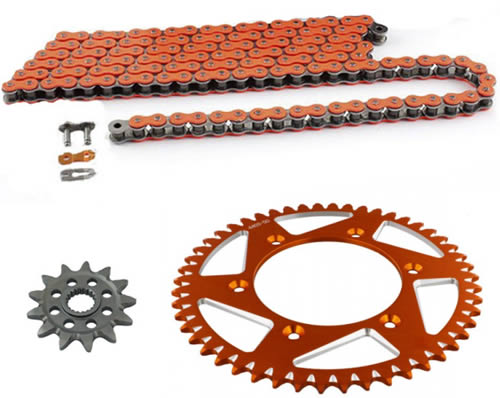
The Sprockets
The front sprocket is often referred to as the drive sprocket or countershaft sprocket.
The rear sprocket is often referred to as the driven sprocket.
The number of teeth on a sprocket should be stamped onto the side of the sprocket, which saves you the hassle of counting them.
Steel is the preferred choice of material for the front sprocket whereas a combination of an aluminium core with steel teeth is now common for the rear.
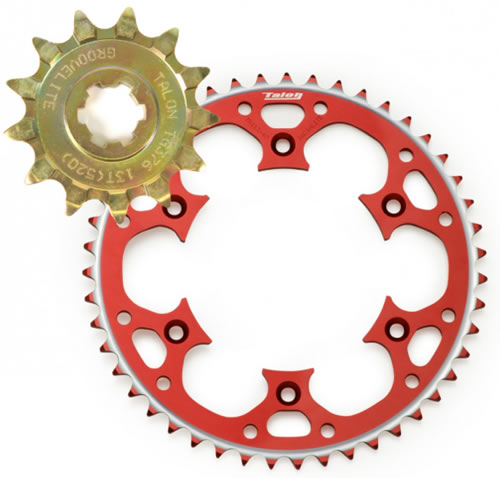
Gear Ratio Calculation
The arithmetic used to work out gear ratio is quite simple:
Divide the rear sprocket tooth number by the front sprocket tooth number.
Example:
Front sprocket – 15
Rear sprocket – 45
45 / 15 = 3
So the gear ratio is 3.
It will take the front sprocket 3 full revolutions to turn the rear sprocket one revolution.

Gear Up Or Down?
You will often hear the term “gear up” or “gear down” and this can get a little confusing, and here’s why.
If someone states they want to “gear up” then they will use a larger front sprocket or a smaller rear sprocket or a combination of both. This will add more top end speed but decrease acceleration. This in turn will lower the gear ratio.
If someone states they want to “gear down” then they will use a smaller front sprocket or a larger rear sprocket or a combination of both. This will lower top end speed but increase acceleration. This in turn will higher the gear ratio.
So a lower gear ratio relates to gearing up i.e. the front sprocket will turn less times for every one revolution of the rear wheel.
And a higher gear ratio relates to gearing down i.e. the front sprocket will turn more times for every one revolution of the rear wheel.
Simply put:
Gearing described as “tall” or “high” = better top speed but less acceleration.
Gearing described as “short” or “low” = better acceleration but lower top speed.
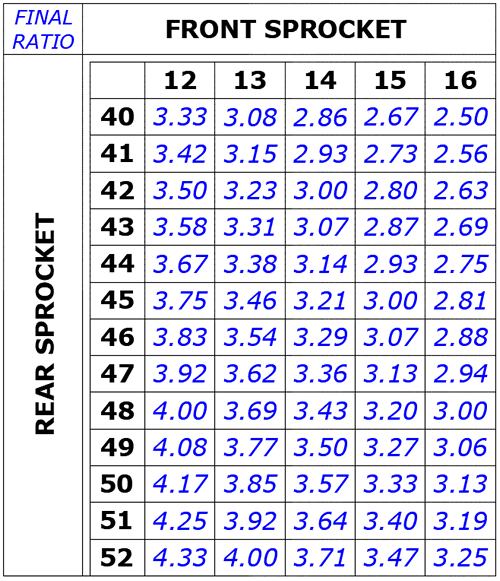
Gearing For Supermoto
Most motocross bikes tend to have a gear ratio of around 4 whereas dual sports are generally between 3 – 4 and supersport bikes have a gear ratio under 3.
Motocross and dual sports are geared for quicker acceleration but have lower top speeds. As Supermotos are mainly used for street riding they require a higher top speed with less acceleration, this means they need a lower gear ratio.
Example:
Let’s say the current gearing is –
Front = 14 tooth
Rear = 44 tooth
Hypothetical top speed = 70 mph
This gear ratio = 3.14
So for a higher top speed we need to “gear up” which decreases the gear ratio.
The new gearing added is –
Front = 15 tooth
Rear = 41 tooth
New hypothetical top speed = 85 mph
New gear ratio = 2.73
What you have gained in top speed you have lost out with some acceleration, this might mean you can’t pop a wheelie in 3rd gear anymore. The engine size and aerodynamics of a motorcycle will also play a large factor in the overall top speed.
Note: If you transfer the original dirt bike sprockets over to the Supermoto wheels you need to remember that the reduced diameter of the new wheels will straightaway lower the original top end speed and increase acceleration.
Gearing Tips
The cheapest way to alter your gear ratio is by replacing the front sprocket. Going up just 1 tooth on the front sprocket is the equivalent to going down 3 teeth on the rear.
Having the optimal gearing for your Supermoto will be a case of trial and error. A good starting point is finding out what the original stock gearing was from the manufacturer. This may also flag up certain limitations that were put in place for safety.
For example, if you fit a smaller front sprocket you’ll need to keep an eye out for the swingarm chain slider as it will most likely wear out quicker. With the rear sprocket, if it’s too large you may encounter alignment problems and clearance issues with the chain guide and chain guard.
Note: Chain tension will always need adjusting after the gear ratio has been changed.
As an Amazon Associate I earn from qualifying purchases. This is at no additional cost to you.
Supermoto Chain Type
There are 4 main types of chain – standard, heavy duty, O-ring and X-ring.
A standard chain is normally used for 250cc motorcycles and under. The heavy duty chain is more commonly used for Motocross, dual sports and is generally OK to use on Supermoto conversions.
O-ring chains tend to be used on motorcycles over 400cc and can retain lubricant more efficiently than heavy duty chains. However, the friction is higher which in turn creates more drag that translates into less power at the rear wheel. X-ring chains are similar to O-ring chains but operate with 40% less friction whilst still sealing in lubricant.
With Supermoto conversions the wider tyre can sometimes cause rubbing on the chain, so opting for a narrower heavy duty chain and not the O-ring or X-ring can provide a simple solution to this. The downside is a heavy duty chain will not last as long.
Chains are sized by pitch and length. For example a 520 – 188 indicates that the chain has a pitch of 520 and has 118 links. There are many different pitches to choose from but the most common sizes for Supermoto are 520, 525 & 530, with 520 being the most popular.
The pitch of a chain is the distance measured from pin to pin and is normally stamped onto the side of a link.
520 = 15.88mm pitch – width 6.35mm
525 = 15.88mm pitch – width 7.85mm
530 = 15.88mm pitch – width 9.53mm
When replacing a rear sprocket for a larger one you may have to add links to the chain.
When you need to add or remove links it is best to do it in 2’s. So if you are adding 1 or 2 teeth on either sprocket you will need to add 2 links to the chain. If you are adding 3 or 4 teeth you will need to add 4 links.
If you are taking away 2 or 3 teeth from either sprocket then you will need to remove 2 links from the chain. If you are taking away 4 or 5 teeth then you will need to remove 4 links.
It is recommended that a new chain is purchased if both sprockets have been replaced.
Note: The split link should always be installed with the closed end facing the direction of travel.
Final Thoughts
Motorcycle chain maintenance can have a large impact on how smoothly your bike will transfer the power from the engine to the rear wheel.
General gunk, dirt and grease has a tendency to build up rather quickly no matter what type of chain you have fitted and this can lead to increased wear.
A heavy duty chain will require more maintenance than an O-ring or X-ring chain as there is no way of retaining the internal lubricant.
Lubricating your chain straight after a ride will allow the lubricant to penetrate more easily because the chain is still warm.
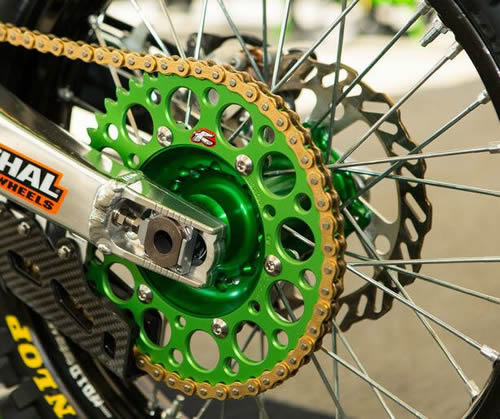

Pingback: Convert A Dirt Bike To Supermoto